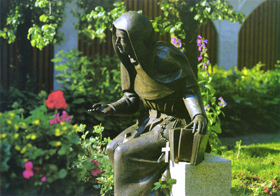Blessed Theresa Gerhardinger
Called, Challenged, and Committed

The statue of Blessed Theresa of Jesus Gerhardinger was created in 1988
by the sculptor, Peter Kuschel from Etzelwang. The photographer was
Gunther Moser. It stands in the garden of the convent at the
Dr. Johanna Decker School of the School Sisters of Notre Dame that
Mother Theresa founded in Amberg, Bavaria in 1839.
Mother Theresa (Caroline Gerhardinger) was born in Bavaria in 1797. The Catholic Church was dealing with the insights and violence of the French Revolution. The music, art, and literature of this cultural context significantly fashioned those who mentored her. This “cast of characters” is helpful in understanding how the School Sisters of Notre Dame were founded. Relive this period by exploring the chapter on "Cultural Context."
In the chapter "Sent into Time," Sister Maria Canisia Engl, SSND, deepens our understanding of this post-Napoleonic period.
In the Prologue of the constitution of the School Sisters of Notre Dame, You Are Sent we read: “In a spirit of creative fidelity to Jesus Christ, the church, and our charism, we commit ourselves, as members of a religious institute of pontifical right dedicated to apostolic works…” A woman’s place in the church of the 19th century was in question. Become familiar with this struggle.
As Mother Theresa exercised her authority and the congregation grew, Archbishop von Reisach began to assume more control. This drama could be viewed in several acts: engage in this drama under Act I: The Gathering Storm. In 2009, Sister Mary Ann Kuttner, SSND translated the letters of Mother Theresa that are used in this segment; her explanatory footnotes provide historical context.
Issues of control surfaced in Act II: Decrees. Imagine the anxiety of Mother Theresa and her sisters as they tried to be faithful to the Spirit and the Church. There is a play included that can be acted out by participants.
In her desperation, Mother Theresa appealed to Pope Pius IX for help. Reflect on her letters to him and consider the issues that were being negotiated. Act III: Appealing to Pope for Help gives greater meaning to “pontifical” status (in contrast to diocesan congregations) for the School Sisters of Notre Dame.
According to the proper channels of the time, the congregation employed Dr. Bernard Schels as envoy to the Vatican officials. Mother Theresa wrote to him with such depth of feeling and insight that these are among the most valuable letters describing this period as written in Act IV: Crises and Clerical Support.
St. John of the Cross described in vivid poetry “The Dark Night.” This spirituality sustained Mother Theresa in her own “dark night.” Consider the depths of anguish transformed into acceptance that fostered her deep contemplative spirit. Listen to a Spanish reading of some of this poetry and pray it in a spirit of hope.
Despite her difficulties receiving Church approval, the missionary spirit of the School Sisters of Notre Dame is evident in the international community that Mother Theresa inspired. During this time the expansion of the School Sisters of Notre Dame was remarkable. Explore the roots of this missionary spirit through the work of Sister Mary Ann Kuttner, SSND.
The transformative power of Eucharistic living gave Mother Theresa the wisdom to stay at the table of dialogue, offering the hand of reconciliation. To understand the compassion and respect of this remarkable woman toward those who caused her such pain, prayerfully reflect on Act V: Reconciliation.
In her sustained quest for truth Mother Theresa’s ability to remain “at the table of dialogue” led to her being named “Blessed” by the church. This process of beatification was begun by the Catholic Women’s Organization in Amberg, Bavaria in 1920. Women who had known the benefits of her dedication to their education initiated this process. View excerpts from the Beatification Ceremony held in Rome on November 17, 1985.
The people of Bavaria also honored her on September 3, 1998, when Mother Theresa was inducted into the Bavarian Hall of Fame (Valhalla). To learn more about the background, and view this significant event, explore Hall of Fame.
In his seminal work entitled The Splendor of the Church, Henri de Lubac, SJ described the reasons he loved the church. In a personal letter to the author, written in 1967 he responded to her questions regarding the fidelity needed today especially by women religious.
Explore the following Acts to learn more about the relationships and the interactions between Blessed Theresa Gerhardinger and Archbishop von Reisach.
To learn more about Blessed Theresa Gerhardinger, explore the following options.
BeatificationCultural ContextHall of FameLetter of de Lubac
Missionary SpiritSent into TimeTheresa's Dark NightA Women's Place
Return to
Blessed Theresa Gerhardinger